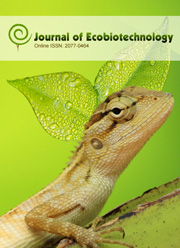Impact of brewery wastewater sludge on microbiological quality of agricultural soil
DOI:
https://doi.org/10.25081/jebt.2019.v11.5506Keywords:
Brewery sludge, microbiological quality, agricultural soilAbstract
Impact of brewery wastewater sludge on microbiological quality of agricultural soil was studied using standard methods. Different concentrations of brewery wastewater sludge were added to soil sample collected from abandoned farm land to produce test soil samples A to C; and a control (without sludge). The samples were allowed to stay for 80 days with exposure to same environmental condition. Standard methods were deployed to isolate and group organisms from the soil samples. Important microbes such as Streptococcus sp., Klebsilla sp., Proteus sp., Vibrio sp., Shigella sp., Micrococcus sp., Pseudomonas sp., Enterobacter sp., Escherichia sp., and Bacillus sp amongst others were isolated. The isolated organisms and their loads were more on the test soil samples against the control. These could be indication of the impact of the brewery sludge on the soil. Organisms isolated and grouped have one or more beneficial role to play with relevance to agricultural soil. This study has revealed the impact of brewery wastewater sludge on microbiological quality of agricultural soil.
Downloads
References
[2]. Kalatzi E, Sazakli E, Karapanagioti HK, Leotsinidis M. Composting of brewery sludge mixed with different bulking 2016. agents.http://uest.ntua. gr/Cyprus 2016/proceedings/pdf/Kalatzi_et_al_Composting_of_brewery_sludge_mixed_with_different_bulking_agents.pd (Accessed on 2nd, April, 2019).
[3]. Olowu RA, Osundiya MO, Onwordi CT, Denloye AA, Okoro CG, Tovide OO, Majolagbe AO, Omoyeni OA, Moronkola BA. Pollution status of brewery sewage sludge in Lagos, Nigeria. International Journal of Research and Reviews in Applied Sciences. 2012;10(1):159-65.
[4]. Vriens L, Van Soest H, Verachtert H. Biological treatment of malting and brewing effluents. Critical Reviews in Biotechnology.1990; 10 (1): 1-46.
[5]. Kanagachandran K, Jayaratne R. Utilization potential of brewery waste water sludge as an organic fertilizer. Journal Institute of Brewing. 2006; 112(2): 92-96.
[6]. Ramya N, Srinivas T, Lakshmi KA. Studies on effect of brewery waste water sludge (BWS) on morphology and yield of chilly (Capsicum annum L.) plant. International Journal of Pharmaceutical Sciences and Research. 2015; 6(1):405-409.
[7]. Senthilraja K. Effect of brewery effluent irrigation and sludge application in combination with organic amendments on growth and yield of sesame (Sesamum indicum L.). International Journal of Current Microbiology Applied Sciences. 2017; 6(12): 965-977.
[8]. Stocks C, Barker AJ, Guy S. The composting of brewery sludge. Journal Institute of Brewing. 2002, 108(4), 452–458.
[9]. Erdem N, Ok SS. Effect of brewery sludge amendments on some chemical properties of acid soil in pot experiments. Bioresource Technology. 2002; 84(3):271-173.
[10]. Luque O, Bracho O, Maier TW. Utilization of brewery waste water sludge for soil improvement. Techical Quarterly Master Brewers Association. 1990;27(1):5–9.
[11]. Cihat K, Gokhan C, Abdullah B, Ouz BK and Roger H. Effects of beer factory sludge on soil properties and growth in sugar beet (Beta vulgaris saccharifera L.), Bioresource Technology. 2003;75-77.
[12]. Stocks C, Barker AJ, Guy S. The composting of brewery sludge. Journal Institute of Brewing. 2002; 108(4): 452–458.
[13]. Kumar S, Sharma MP, Sharwan K. Performance evaluation of brewery waste water treatment plant. International Journal of Engineering Practical Research. 2013; 2:105-111.
[14]. Chaitanyakumar S, Azeem U, Bhupattthi R. Efficiency assessment of combined treatment technologies. Indian Journal of Fundamental and Applied Life Sciences. 2011; 1(2):138?145
[15]. Kanagachandran K, Jayaratne R. Utilization potential of brewery waste water sludge as an organic fertilizer, Journal of Institute of Brewing. 2006; 112(2): 92-96.
[16]. Ahmadi H, Vahid A, Farshad D, Abdolati S. Effect of different levels of nitrogen fertilizer on yield, nitrate accumulation and several quantitative attributes of five Iranian spinach accessions. Journal of Agricultural and Environmental Science. 2010; 8(4): 468-473.
[17]. Nihal E, Sonay S, Ru OK. Effect of brewery sludge amendments on some chemical properties of acid soil in pot experiments, Journal of Bioresource Technology. 2002; 84: 271-273.
[18]. Mohimi AO, Ekpo KE, Chukwuedo ME. Economic importance and application options of some industrial sludge conditioned by different treatment methods, African Journal of Biotechnology 2010; 7: 2434-2440
[19]. Holt JG. The shorter bergey`s manual of determinative bacteriology. 8th ed. The Williams and Wilkins Company, Batimore, MD, USA.1982.
[20]. Prescott LM, Harley JP Kelin DA. Microbiology, 6thed., McGraw Hill, London. 2005; pp.135-140.
[21]. Barnett HL, Hunter BB. Illustrated genera of imperfect fungi. 3rd ed. Burgess Publishing Company, Minnesota, USA. 1972.
[22]. Vrieze J.The littlest farmhands. Science. 2015; 349 (6249): 680–683.
[23]. Christopher J. Living soils: the role of microorganisms in soil health. 2017. http://www.futuredirections.org.au/publication/living-soils-role-microorganisms-soil-health (accessed on 12 Feb., 2019).
[24]. Jelen BI, Giovannelli D, Falkowski PG. The Role of microbial electron transfer in the coevolution of the biosphere and geosphere. Annual Review of Microbiology. 2016; 70 (1): 45–62.
[25]. Sylvia DM, Jeffry JF, Peter GH, David AZ. Principles and applications of soil microbiology. Upper Saddle River: Prentice Hall, 1998.
[26]. Cakmaki ML, Evans HJ, Seidler, R.J. Characteristics of a nitrogen-fixing Klebsiella oxytoca isolated from wheat roots. Plant and Soil. 1981; 61: 53–64.
[27]. Riggs PJ, Chelius MK, Iniguez AL, Kaeppler SM, Triplett EW. Enhanced maize productivity by inoculation with diazotrophic bacteria. Australian Journal of Plant Physiology. 2001; 28 (9): 829–836.
[28]. Belimov A, Hontzeas N, Safronova VI, Demchinskaya SV, Piluzza G, Bullitta S, Glick BR. Cadmium-tolerant plant growth-promoting bacteria associated with the roots of Indian mustard (Brassica juncea L. Czern.). Soil Biology and Biochemistry. 2005; 37: 241–250.
[29]. Sheng XF, Xia JJ. Improvement of rape (Brassica napus) plant growth and cadmium uptake by cadmium-resistant bacteria. Chemosphere. 2006; 64:1036 – 1042.
[30]. Rajkumar M, Nagendran R, Kui JL, Wang HL, Sung ZK. Influence of plant growth promoting bacteria and Cr6+ on the growth of Indian mustard. Chemosphere. 2006; 62: 741 – 748. [31]. Ma Y, Rajkumar M, Freitas H. Inoculation of plant growth promoting bacterium Achromobacter xylosoxidans strain Ax10 for the improvement of copper phytoextraction by Brassica juncea. Journal of Environmental Management. 2009;90(2):831-7. [32]. James JH. The Role of soil bacteria. Fact Sheet, Agricultural Natural Resources. SAG 13-11 accessed on 5th Jan., 2019.
[33]. Sylvia DM, Hartel PG, Fuhrmann JJ, Zuberer DA. Principle and Application of Soil Microbiology. 2nd ed. Edited by David M. Sylva, Pearson Prentice Hall. 2005.



 .
.